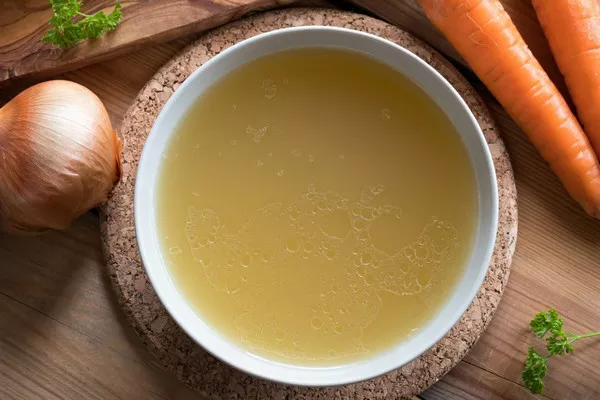Bone broth is a traditional, nutrient-rich beverage that has gained popularity for its potential health benefits. With a history dating back centuries, bone broth has found its place in modern diets as a wholesome and versatile ingredient. Derived from simmering animal bones, connective tissues, and aromatics in water, bone broth is rich in minerals, amino acids, and gelatin, which contribute to its numerous health advantages. In this article, we will explore five compelling health benefits of bone broth and provide you with a step-by-step guide on how to make it at home.
5 Health Benefits of Bone Broth
1. Supports Joint Health and Reduces Inflammation
One of the primary components of bone broth is collagen, a protein found in the connective tissues of animals. Collagen is essential for maintaining the health of joints, tendons, and ligaments. As we age, our body’s natural collagen production decreases, leading to joint discomfort and increased susceptibility to injuries. Consuming bone broth can provide the body with the building blocks necessary to support joint health and potentially reduce the risk of arthritis and other inflammatory conditions.
Additionally, bone broth contains glycosaminoglycans (GAGs), which are compounds that contribute to joint lubrication and cushioning. These GAGs, including glucosamine and chondroitin, are often used as supplements to alleviate joint pain. Regular consumption of bone broth may offer a more natural way to provide these compounds to the body and promote joint comfort.
2. Aids in Digestion and Gut Health
Bone broth contains gelatin, a substance that forms when collagen is cooked. Gelatin has been shown to promote proper digestion by supporting the lining of the digestive tract. A healthy gut lining is crucial for nutrient absorption and preventing the leakage of harmful substances into the bloodstream.
Moreover, bone broth is rich in amino acids, such as glutamine, which can help maintain the integrity of the intestinal barrier. Glutamine is considered a “conditionally essential” amino acid, meaning that the body may require more of it during times of stress or illness. Including bone broth in your diet can provide an additional source of glutamine to support gut health.
3. Promotes Skin Health and Collagen Production
Collagen’s benefits extend beyond joint health—it also plays a vital role in maintaining the elasticity and firmness of the skin. Consuming bone broth may contribute to healthy, glowing skin by providing the necessary amino acids and nutrients to support collagen production.
The amino acids found in bone broth, such as proline and glycine, are essential for skin health. Proline, for instance, is involved in collagen synthesis and has been linked to skin repair. Glycine helps form collagen and elastin, both of which are integral to maintaining youthful-looking skin. Regular consumption of bone broth could potentially lead to improved skin texture and a reduction in the appearance of wrinkles.
4. Boosts Immune System Function
Bone broth contains various nutrients that can support a healthy immune system. The amino acid arginine, present in bone broth, is known for its immune-enhancing properties. It plays a role in regulating immune responses and promoting the production of white blood cells that defend the body against infections.
Additionally, bone broth is rich in minerals such as zinc, magnesium, and calcium, which are essential for immune function. Zinc, in particular, is involved in numerous immune processes, including the production and function of immune cells. Regularly consuming bone broth as part of a balanced diet can contribute to a robust immune system.
5. Provides Hydration and Nutrient Intake
Staying hydrated is essential for overall health, and bone broth can serve as a hydrating beverage, especially during cold weather or when recovering from illness. The warm and flavorful nature of bone broth can be soothing and comforting, making it an excellent choice for hydration.
Bone broth’s nutrient density also makes it a valuable addition to your diet. It contains a range of essential minerals, including calcium, phosphorus, and magnesium, which are vital for bone health. Additionally, the amino acids found in bone broth support various bodily functions, making it an efficient way to nourish your body with essential nutrients.
See Also: Top 15 Calcium-Rich Foods & Benefits
How to Make Bone Broth at Home

Making bone broth at home is a straightforward process that allows you to control the ingredients and tailor the flavor to your preferences. Here's a step-by-step guide to creating a delicious and nutritious batch of bone broth:
- Bones ((chicken, beef, pork, or a combination))
- Aromatics ( (onions, garlic, celery, carrots, etc.))
- Herbs and spices ((bay leaves, peppercorns, thyme, rosemary, etc.))
- Apple cider vinegar ((optional, helps extract minerals from the bones))
- Salt ((added towards the end of cooking))
-
Select the Bones: You can use a variety of bones, such as leftover bones from roasted or cooked meats, or you can buy them from a butcher. Using a mix of meaty bones, joint bones, and marrow bones can result in a well-rounded broth.
-
Roast the Bones (optional): If desired, you can enhance the flavor of your bone broth by roasting the bones in the oven at around 375°F (190°C) for about 20-30 minutes until they are browned. This step is optional but can add depth to the flavor.
-
Prepare Aromatics and Vegetables: While the bones are roasting, roughly chop the aromatics and vegetables. These can include onions, garlic, celery, carrots, and any other vegetable scraps you have on hand.
-
Combine Ingredients in a Pot: Once the bones are roasted (or if you're skipping the roasting step), place them in a large stockpot. Add the aromatics, vegetables, herbs, and spices to the pot. You can also add a splash of apple cider vinegar at this point.
-
Add Water: Cover the bones and aromatics with enough water to fully submerge them. The exact amount will depend on the size of your pot and the quantity of bones you're using. Leave a couple of inches of space at the top to prevent boiling over.
-
Bring to a Simmer: Place the pot on the stovetop over medium heat. Slowly bring the mixture to a gentle simmer. As it starts to simmer, you might notice foam or impurities rising to the surface. Skim off this foam using a spoon to help keep your broth clear.
-
Simmer: Once the broth is simmering, reduce the heat to low and let it simmer for a long period of time. Chicken bone broth can simmer for about 12-24 hours, while beef bone broth might need 24-48 hours. The longer you simmer, the richer the flavors will be and the more nutrients will be extracted from the bones.
-
Add Salt: Towards the end of the cooking time, you can add salt to taste. It's a good idea to wait until near the end because the broth will reduce as it simmers, and you can better gauge the saltiness then.
-
Strain: After the simmering time is complete, remove the pot from the heat and let it cool slightly. Strain the broth through a fine mesh sieve or cheesecloth into another container to remove the bones and aromatics. Discard the solids.
-
Cool and Store: Allow the broth to cool completely before refrigerating or freezing it. You can store it in airtight containers in the refrigerator for up to a week or freeze it for several months.
Tips for Making Bone Broth
Certainly! Here are some additional tips to help you make the best bone broth:
1. Use High-Quality Bones: If possible, use organic, grass-fed, or pasture-raised bones. These types of bones tend to have more nutrients and flavors.
5. Don’t Overfill the Pot: Leave some space at the top of the pot to prevent boiling over as the broth simmers.
6. Skim Off Foam: During the initial stages of simmering, foam and impurities might rise to the surface. Skim these off with a spoon to help clarify the broth.
7. Use Aromatics Wisely: Aromatics like onions, garlic, celery, and carrots add flavor. You can adjust the quantities based on your taste preferences.
8. Add Herbs and Spices: Bay leaves, peppercorns, thyme, rosemary, and other herbs and spices can enhance the flavor profile of your broth. Experiment with different combinations.
9. Simmer Slowly: Low and slow simmering over an extended period extracts the maximum nutrients and flavors from the bones. Avoid rapid boiling, as it can make the broth cloudy.
10. Be Mindful of Salt: Add salt towards the end of cooking. The broth will reduce as it simmers, and this prevents it from becoming overly salty.
FAQs About Making Bone Broth
Q1. Can I mix different types of bones in my bone broth?
Yes, you can mix different types of bones to create a more complex flavor profile. Combining meaty bones, joint bones, and marrow bones from different animals can yield a richer and more nutritious broth.
Q2. Do I need to roast the bones before making bone broth?
Roasting the bones before making bone broth is optional but recommended. Roasting can enhance the flavor and color of the broth by caramelizing the proteins on the bones.
Q3. Can I use a slow cooker or an Instant Pot to make bone broth?
Yes, you can use a slow cooker or an Instant Pot to make bone broth. The advantage of using these appliances is that they allow for longer simmering times without the need to monitor the stove. Slow cookers and Instant Pots are great for convenience and safety.
Q4. How long should I simmer bone broth?
The simmering time for bone broth can vary depending on the type of bones and your desired flavor and nutrient extraction. Chicken bone broth typically simmers for 12-24 hours, while beef bone broth can go for 24-48 hours. Longer simmering times tend to yield richer broths.
Q5. Why do some recipes recommend adding vinegar to bone broth?
Adding a small amount of acidic ingredient, like apple cider vinegar, to bone broth can help extract minerals from the bones. It’s believed that the acidity helps break down the bones and release more nutrients into the broth.
Q6. Can I reuse bones to make a second batch of bone broth?
You can reuse bones for a second batch of bone broth, but the resulting broth may be less flavorful and nutrient-rich. If you’re making a second batch, you might need to increase the simmering time and add more aromatics and seasonings to compensate for the diminished flavor of the bones.
Q7. Can I freeze bone broth?
Yes, you can freeze bone broth. Allow the broth to cool completely, then portion it into airtight containers or freezer-safe bags. Leave some space at the top to allow for expansion as the broth freezes. Frozen bone broth can be stored for several months.
Q8. Is it normal for bone broth to gel when cooled?
Yes, it’s normal for bone broth to turn into a gel-like consistency when cooled. This is a sign that the broth contains a high amount of gelatin, collagen, and other nutrients extracted from the bones during the simmering process. Gelled bone broth will return to a liquid state when heated.
In Conclusion
Bone broth is a nutrient-dense elixir with a history steeped in tradition and a host of potential health benefits. From supporting joint health and digestion to promoting skin health and boosting the immune system, the advantages of incorporating bone broth into your diet are numerous. By harnessing the power of collagen, amino acids, and minerals, you can nourish your body and enhance your overall well-being. With a simple homemade recipe at your disposal, you can easily incorporate this wholesome beverage into your culinary repertoire and enjoy its delightful taste and healthful properties.

